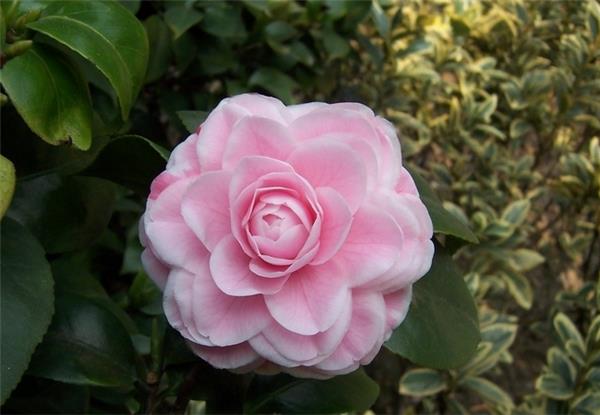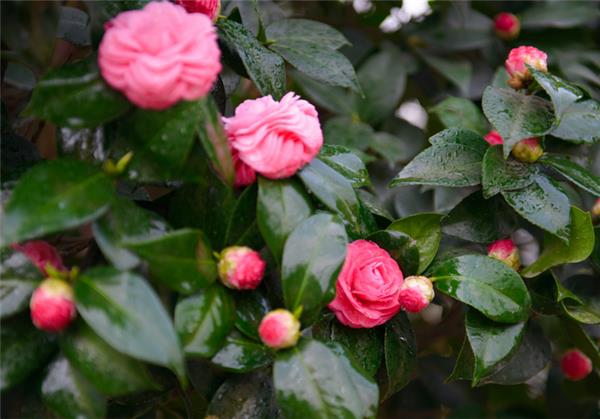Introduction of Camellia Rocks of Eighteen Scholars
When it comes to camellia, everyone knows something about it, so how much do you know about camellia Rocks of Eighteen Scholars? today we will introduce Camellia Rocks of Eighteen Scholars to you.

Introduction of Camellia Rocks of Eighteen Scholars
Rocks of Eighteen Scholars camellias are one of the treasures of camellias and are deeply loved by people. Its tree shape is beautiful, the flower structure is peculiar, the florescence is January-February, small to medium flower, the flower is double, composed of more than 130 petals of 70Mutual, the hexagonal tower-shaped Corolla is clearly hierarchical, arranged orderly, very beautiful; the flower pattern is elegant and exquisite, the flower color is rich, the flower is dense, and sometimes the flowers of different colors, such as pink, red, white, red and white stripes, can bloom on one plant at the same time. The plant grows slightly, natural crown is good, leaf color is dark green, leaf surface is bright, glossy, leaf shape is symmetrical, close to oval, full leaf quality. Like warm, moist and semi-overcast environment.

Rocks of Eighteen Scholars Camellia is one of the treasures of camellias, which refers to the number of petals rather than the number of colors. The flower is made up of more than 130 petals of 70 Rocks of Eighteen Scholars, and the petals of adjacent corners are arranged for about 20 rounds, mostly 18 rounds, so it is called "Rocks of Eighteen Scholars".
It has a beautiful tree shape and a peculiar flower structure. It has a hexagonal tower-shaped Corolla composed of more than 70Mel 130 petals, with distinct layers, orderly arrangement and very beautiful appearance. Its common colors are scarlet and scarlet. Pink and all white.
There are three varieties of Rocks of Eighteen Scholars camellias: pink Rocks of Eighteen Scholars, Baccalaureate and White Rocks of Eighteen Scholars, all of which are monochromatic.

Growth habits of Camellia Rocks of Eighteen Scholars
This variety is afraid of the wind and likes the sun, and should be planted in sandy loam, loess or humus with good ventilation, warm and moist, good drainage, loose and fertile soil. PH5.5-6.5is the best. The optimum temperature is between 20-32 ℃, stop growing when the temperature is above 29 ℃, and the leaves will be anxious at 35 ℃, which requires a certain temperature difference. Environmental humidity more than 70%, can withstand-8 ℃ low temperature (natural overwintering, Yuncha slightly less cold-resistant), in the south of the Huaihe River generally can naturally overwintering acid soil, and requires good air permeability. The root hair is developed and can usually be cultivated with a mixture of peat, sawn wood, laterite, humus, or above. Camellias can not be shaded in spring, autumn and winter, and 50% shading can be used in summer.

Propagation method of Camellia on Rocks of Eighteen Scholars
Barge in
In the rainy season from May to June, select the young mother tree, cut one-year-old shoots from the top, about 10cm, remove the lower leaves, flatten the lower leaves with a blade at the bottom of the node, keep one lateral bud at the top, and insert 2-3 leaves into the medium of river sand or gravel. After insertion, cover the grass curtain to shade, strengthen the foliar spray, maintain the air humidity of the bed, and promote rooting. In order to improve the survival rate of the cuttings, the cuttings can be soaked in 50-100ppm ABT rooting powder solution for 8-12 hours.
Grafting
Select strong seedlings or camellia varieties that are easy to survive as rootstocks, cut off at 4-5cm from the ground, split about 1.5cm deep through the pith, use 1-2-year-old branches as scions, keep 1-2 leaves in the upper part of the scion, cut into wedges in the lower part, insert into the split of the rootstock, the cambium of the two sides should be closely joined, and then tied with plastic tape. After grafting, cover the scion with a plastic bag and tie it with a belt below, but not too tight, so as to form water droplets in the bag and keep dripping on the rootstock. Add a wrapping paper bag to the outside of the plastic bag to block out the direct sunlight.
Bud insertion
Take each bud node as a segment, retain a leaf, about 1.5cm, the lower oblique cut, and then insert into the medium, the depth to cover the branches as the degree. This method can make full use of branches and is suitable for mass reproduction.
That's all for today's introduction of Camellia Rocks of Eighteen Scholars. I hope the above content can be explained to everyone!
Related
- Wuhan Hospital Iron Tree Blooming Result Was Instantly Frightened by the Gardener Master
- Which variety of camellia is the most fragrant and best? Which one do you like best?
- What is the small blue coat, the breeding methods and matters needing attention of the succulent plant
- Dormancy time and maintenance management of succulent plants during dormancy
- Minas succulent how to raise, Minas succulent plant pictures
- What are the varieties of winter succulent plants
- How to raise succulent plants in twelve rolls? let's take a look at some experience of breeding twelve rolls.
- Attention should be paid to water control for succulent plants during dormant period (winter and summer)
- Watering experience of twelve rolls of succulent plants
- Techniques for fertilizing succulent plants. An article will let you know how to fertilize succulent plants.



